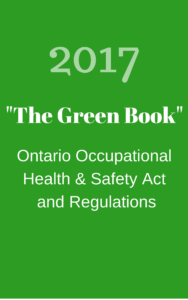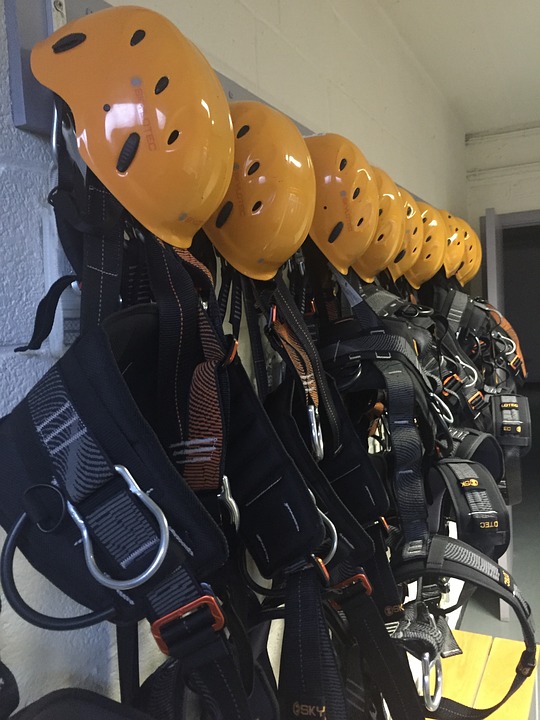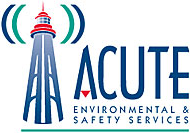2017 OHSA Green Book Health and Safety Training Laws Employees Should Know
With a new year comes new amendments to the OHSA “Green Book.” The Ontario Health and Safety Act (OHSA) is also known as the Green Book. The Green Book contains laws and regulations for occupations from teachers to farmers to healthcare workers to construction workers. Employers are obligated to post a copy of the Green Book in their workplace and must keep track of revision dates and ensure they have the latest version available. If you are an employer, read what you should know about the 2017 OHSA Green Book here. It is important that Employees know and understand their rights and what the 2017 changes mean for their jobs. Contact us today if you have more questions and to find out more about our quality training in your workplace or on-site at ACUTE’s proven training facilities!
Where Can I Find The OHSA Green Book?

Remember, the Green Book must be posted in all workplaces in an accessible area where all employees can read it. Employers should choose the publication that is specific to your business sector. For example, if you work on construction projects, there is the Occupational Health and Safety Act and Regulation for Construction Projects, Ontario Regulation 213/91; Sept. 2016.
Employers can obtain a copy of the OHSA here:
- You can order a copy of the Green Book from ServiceOntario Publications
- You can call Service Ontario Publications via this number: 1 800-668-9938
- You can access the OHSA online here
- You can also access A Guide to the Occupational Health and Safety Act online
Under the Occupational Health and Safety Act (OHSA), employers must post a copy of the Green Book in a location that all employees can access. As an employee, you have the right to be able to easily access the Green Book in your workplace at all times. The Green Book is often posted on office bulletin boards or cork boards and is typically in a location where employees pass by often. If you cannot find a copy of your office’s Green Book, ask your employer to show you where you can find it.
Source: www.cfib-fcei.ca
Health and Safety Laws Ontario: Recent Changes To The OHSA Green Book
As an employee, it’s important to know what the recent OHSA amendments mean for you and your workplace. Some changes may not affect you, such as sector-specific changes. However, amendments to WHMIS and the Workplace Harassment Bill may affect you and your training requirements. If you are unsure how these amendments may affect you, don’t hesitate to ask your employer.
- Workplace Harassment – Bill 132: Some of the amendments under Bill 132 include the Sexual Violence and Harassment Action Plan Act, new definitions for the terms “workplace harassment” and “workplace sexual harassment,” and new rules for the way employers must investigate workplace sexual harassment allegations.
See this Globe and Mail article for more information. - WHMIS 2015 – Bill 85: Amendments to the Workplace Hazardous Materials Information System (WHMIS) 2015 take place in three stages. During this time, WHMIS 1988 will be slowly phased out. Phase 1 began in February 2015, Phase 2 begins in June 2017, and Phase 3 begins in June 2018. Click here to see the details from the MLITSD.
- Construction Projects – O. Reg. 242/16, amending O. Reg. 213/91: Amendments made in regards
 to strengthening and clarifying the requirements for using suspended access equipment. The amendments came into force on January 1, 2017. Some of these amendments include:
to strengthening and clarifying the requirements for using suspended access equipment. The amendments came into force on January 1, 2017. Some of these amendments include:
- Requirements for roof plans and other specific work plans
- New training requirements for workers who may use or inspect suspended access equipment
- Enhancement of the existing inspection, testing, and maintenance requirements
- For the full list and more information, visit the Ontario General Contractors Association and the MLITSD Notices page.
- Confined Space – O. Reg. 346/15, amending O. Reg. 632/05: Changes were made to stay consistent with the amendment of Regulation 888 – “Control of Exposure to Biological or Chemical Agents Regulation.”
Visit the MLITSD Notices page for more information. - Mining – O. Reg. 265/15, amending R.R.O. 1990, Reg. 854: Various Amendments were made to Regulation 854 (Mines and Mining Plants). Some of these amendments include:
- New requirements for mines and mining plants to conduct risk assessment and formal traffic management programs
- Strengthening existing water management requirements
- Updating surface diamond drill operations training requirements
- For the full list as well as more information, visit the MLITSD Notices page.
For more information and a complete listing of all amendments made to the OHSA, visit the MLITSD Notices page and the Ontario e-Laws page.
Source: www.carswell.com
What Employees Need To Know
The OHSA is meant to protect workers from hazards and dangers on the job. However, employees also have duties and responsibilities under this act. It is important for employees to be aware of both their rights and responsibilities while in the workplace.
Know Your Rights
The following lists the rights workers have as outlined by the Ontario Ministry of Labour, Immigration, Training and Skills Development. The OHSA protects workers who exercise these rights. Workers cannot be punished by their employers for exercising these rights.
- The Right to Participate – Employees have the right to be part of the process in both identifying and resolving health and safety concerns in the workplace.
- The Right to Know – Employees have the right to know about any and all hazards they may be exposed to on the job. WHMIS is an important component of this right.
- The Right to Refuse Work – Employees have the right to refuse work that they believe is unsafe to themselves or others.
Remember, these guidelines are for all workplaces, even “safe” work environments. There are hazards even in an office workplace environment, and it is important that all workers have a right to participate, a right to know, and a right to refuse work no matter where they work.
Source: https://www.labour.gov.on.ca
Know Your Responsibilities
The following lists the responsibilities workers have on the job as outlined by the Ontario Ministry of Labour, Immigration, Training and Skills Development. Workers are responsible for acting appropriately in the workplace, including around equipment and machinery. As an employee, you should never operate any machinery or equipment in a way that could harm yourself or anyone else around you.
- Employees must comply with the OHSA rules and regulations
- Employees must use or wear any equipment required by their employer
- Employees must inform their employer or supervisor of any missing or defective protective equipment
- Employees must report to their employer or supervisor any hazard or violation of the OHSA
- Employees must not remove or use incorrectly any protective device required by their employer or required by the OHSA
Source: https://www.labour.gov.on.ca
Know How to Get Involved: The Joint Health and Safety Committee

A great way for employees to get involved in their own workplace health and safety is by supporting their Joint Health and Safety Committee (JHSC). The JHSC of each workplace is made up of workers and management representatives. The JHSC has the right to: identify hazards, obtain information from and make recommendations to employers, investigate a worker’s refusal of work, and investigate accidents that occur at work.
The primary role of those on the JHSC is to identify any hazards in the workplace and make them known to the employer, creating a healthier and safer workplace!
Source: https://www.labour.gov.on.ca
ACUTE – Ensuring Quality Training and Education
As an employee, it’s important to feel confident in your training. The best way to ensure compliance with the new OHSA Green Book regulations and requirements is by receiving the best hands-on training and ensuring that your trainer helps to build excellent team skills. ACUTE does more than help you comply with laws. Here are some ways that ACUTE goes beyond government compliance in Ontario health and safety training.
- Open Door Instructor-Student Partnersh
 ip: ACUTE’s training services emphasize client participation. Staff foster relationships with clients and serve as a touchstone for advice moving forward.
ip: ACUTE’s training services emphasize client participation. Staff foster relationships with clients and serve as a touchstone for advice moving forward. - Serving Your Team and Industry: With a vast array of clients in the manufacturing, construction, health, academic, and government sectors, ACUTE brings the best safety practices from across the spectrum to your workplace.
- 100 Years Combined Experience: ACUTE provides comprehensive health and safety training, on-site safety services, and consulting services. With over 100 years of combined experience, our staff offers more than theoretical or abstract ideas. ACUTE offers solutions.
- Track Record of Success: ACUTE is rated 4.9/5 stars on Google reviews, demonstrating a commitment to our clients, quality, and a passion for training.
Contact us today for quality training in your workplace or on-site at ACUTE’s proven training facilities!


